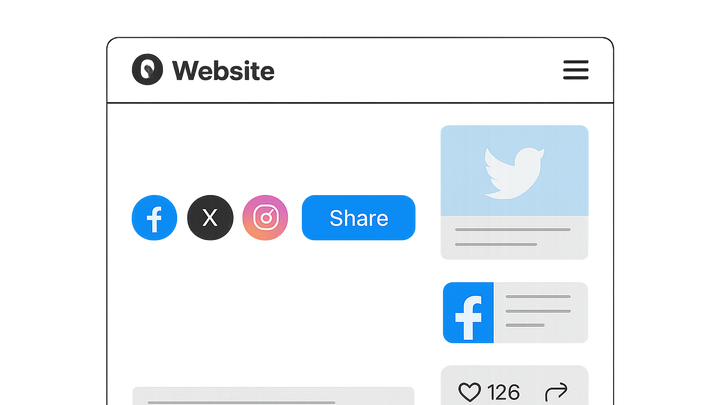Published on 2025-06-29T19:32:04Z
What is Social Media Integration? Examples for Social Media Integration.
Social Media Integration is the practice of incorporating social media elements—such as share buttons, follow buttons, embedded feeds, and social login—directly into your website. This integration fosters user engagement, provides social proof, and can positively influence your site’s SEO. When done thoughtfully, it enhances the user experience (UX), boosts conversion rates by simplifying sharing and authentication, and contributes to a stronger brand presence. Tools like Prevue.me can audit your existing integrations and offer actionable critiques for improving lead generation, accessibility, and overall performance. By aligning social media integration with your broader CRO and SEO strategies, you ensure that these features support your marketing goals without undermining site speed or usability.
Social media integration
Embedding social media features on a website to boost engagement, enhance SEO, and drive conversions.
Importance of Social Media Integration
Integrating social media into your website is not just about adding icons; it’s about creating a seamless bridge between your brand and your audience. In the realms of CRO, UX, and SEO, social media features can:
- Boost Engagement by encouraging users to like, share, and comment directly from your site.
- Enhance SEO through increased sharing and backlink potential.
- Provide Social Proof that builds trust and credibility, driving higher conversion rates.
-
Boosting user engagement
Social media elements invite users to interact with your content in real time, increasing time on site and reducing bounce rates.
- Real-time interactions:
Users can comment or share without leaving the page, making the experience more dynamic.
- Community building:
Embedded feeds help showcase a vibrant community, encouraging others to join the conversation.
- Real-time interactions:
-
Improving seo with social signals
When visitors share content, it generates valuable social signals and potential backlinks that search engines recognize.
-
Enhancing conversion rates
Displaying social proof—like follower counts and user testimonials—can increase trust and nudge users toward desired actions.
Types of Social Media Integration
There are multiple ways to weave social media into your site. Choosing the right method depends on your goals:
- Share Buttons for easy content distribution.
- Embedded Feeds to display live updates.
- Social Login to simplify account creation.
- Follow Buttons to grow your audience.
- Social Proof Widgets to showcase credibility.
-
Share buttons
Buttons that allow users to share your content on platforms like Facebook, Twitter, and LinkedIn with one click.
-
Embedded social feeds
Displaying live content from social platforms directly on your site keeps pages fresh and engaging.
- Facebook feed embeds:
Show public posts, comments, and events from a Facebook Page.
- Instagram hashtag galleries:
Display curated posts tagged with your brand’s hashtag.
- Twitter timelines:
Embed Twitter timelines or individual tweets for real-time updates.
- Facebook feed embeds:
-
Social login
Allow users to log in or register using their existing social media accounts, reducing friction in the signup process.
- Facebook login:
Authenticate users via their Facebook credentials.
- Google sign-in:
Use Google accounts for quick and secure access.
- Facebook login:
-
Follow buttons
Let visitors follow your social profiles directly from your website, growing your social audience.
-
Social proof widgets
Show live follower counts, likes, or user testimonials to boost credibility.
Best Practices for Social Media Integration
Implement these guidelines to ensure your social media features support both UX and CRO:
- Strategic Placement for maximum visibility.
- Design Consistency to maintain brand coherence.
- Mobile Optimization for seamless experiences on all devices.
- Accessibility to ensure inclusivity.
-
Strategic placement
Position social media elements where users are most likely to engage, such as near key calls to action or within content.
- Above the fold:
Ensure share and follow buttons are visible without scrolling.
- Within content:
Embed share buttons in blog posts or product descriptions.
- Sidebar and footer:
Use persistent social links in navigation areas.
- Above the fold:
-
Design consistency
Match the style of social buttons and widgets to your site’s visual identity to avoid jarring elements.
-
Mobile optimization
Ensure social elements are responsive and touch-friendly on all screen sizes.
-
Accessibility considerations
Make social features accessible by using ARIA labels and ensuring keyboard navigation.
- Aria labels:
Provide descriptive labels for screen readers.
- Keyboard navigation:
Ensure users can tab to and activate social buttons without a mouse.
- Aria labels:
Tools and Examples
Leverage these tools and real-world examples to optimize your social media integration strategy and get targeted critiques.
-
Prevue.me for actionable critiques
Use prevue.me to receive expert evaluations on your social media integration’s impact on CRO, UX, SEO, and accessibility, with prioritized recommendations for lead generation.
-
Native platform plugins
Platforms like WordPress offer plugins (e.g., Smash Balloon, Jetpack) to easily add and customize social feeds and sharing options.
- Smash balloon social photo feed:
Embed Instagram galleries with customization options.
- Jetpack social:
Add share buttons, publicize posts, and show social stats.
- Smash balloon social photo feed:
-
Custom api integrations
For full control, use social platforms’ APIs (e.g., Facebook Graph API, Instagram Basic Display API) to build tailored experiences.
- Facebook graph api:
Access pages, posts, and user data for dynamic embeds.
- Instagram basic display api:
Fetch user media and profile information for custom widgets.
- Facebook graph api:
